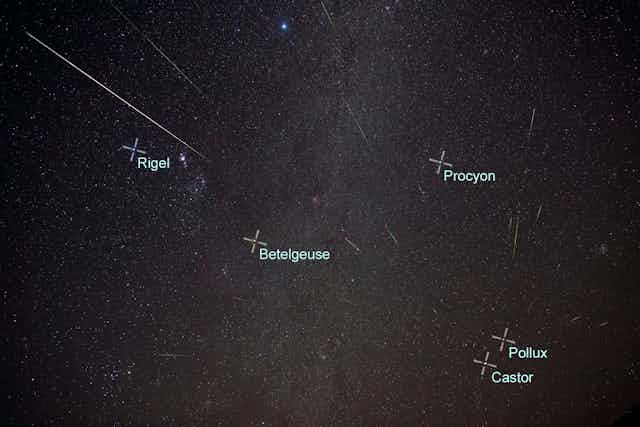The annual Geminid meteor shower is one of the highlights of every year and 2015 promises to be extra special, particularly for those in Australia.
The reason? The moon, which often interferes with our view of meteor showers by washing out all but the brightest members, will be just three days from new at the peak of the Geminids this month. As such, the best rates will be visible in dark, moonless skies.
What’s more, the timing of the event is perfect for Australia. The forecast maximum is expected to occur during the early hours of Tuesday, December 15, when the Geminid radiant (the point in the sky from which meteors appear to radiate) is riding high in the Australian sky.
The Geminids were first observed just one hundred and fifty years ago, relatively recently in astronomical terms. At first, just a few meteors were seen, but over the years the maximum rate observed has climbed.
For the past couple of decades, the annual peak has regularly reached (or exceeded) 120 meteors per hour. These high rates, the general brightness of the meteors, and the reliability of the Geminids combine to make it one of the best showers of the year.
The origins
Meteor showers occur when the Earth, on its orbit around the sun, passes through a swathe of debris left behind by one of the solar system’s small bodies. In most cases, the parent object is a comet, but in the case of the Geminids, the parent is actually a disintegrating asteroid named 3200 Phaethon.
Phaethon is a small, rocky object that has a remarkably eccentric orbit, which brings it closer to the sun than any other named asteroid.
At perihelion, it is just 20 million kilometres from the sun (well inside the orbit of Mercury) and its surface bakes in the daytime and freezes at night. With a rotation period of less than four hours, the constantly alternating extremes of temperature takes its toll on the asteroid’s surface.
The continual expansion and contraction causes Phaethon’s rocky surface to fracture and break. As these fragments are shed, they tend to spread around the asteroid’s orbit. It is this debris stream that Earth is passing through right now, to create the annual Geminid meteor shower.
Heading for peak activity
Unlike the Perseids and Quadrantids, two of the year’s other finest showers, the Geminids are easily observed from both the northern and southern hemispheres. This makes them a true annual treat, wherever you are on the planet.

The Geminids are already underway, and will slowly build towards their peak on Tuesday, December 15. Those peak rates usually last around a day or so, but are then followed by a rapid decay in the number of meteors seen. The shower ceases to be active just three days after maximum.
The time of the peak is expected to occur around 4am AEST (Qld), 5am AEDT (NSW, ACT, Vic and Tas), 4:30am ACDT (SA), 3:30am ACST (NT) and 2am AWST (WA).
How to see the Geminids
Although the Geminids can be observed from anywhere in Australia, the further north you live, the higher the radiant will appear in the sky and the better your view will be.
The radiant of the shower rises in the late evening (see the table, below). It’s not possible to see meteors before then, but once the radiant rises the show will improve, hour on hour as the radiant gets ever higher in the sky.
For the first couple of hours after the radiant rises, even on the night of maximum, meteors will likely be infrequent, but these Earth-grazers can be truly spectacular. Entering Earth’s atmosphere at the shallowest of shallow angles, they can blaze a trail across almost the entire night sky.
As the night passes, and the radiant rises ever higher, rates should increase. The best way to see the greatest number of meteors is to first find the radiant in the sky.

The Geminids appear to come from close to the bright star Castor, one of the two brightest stars in Gemini (hence the name “Geminids”).
Gemini can found below the constellation of Orion, as seen from the southern hemisphere. It rises in the north-east in the late evening, then passes through north to the north-west as the night progresses.

Once you’ve found the radiant, turn your gaze around 30 to 45 degrees away, either to the left or the right (look towards the direction with the least light pollution for the best results). Then look about 30 to 45 degrees above the horizon.
Looking this distance from the radiant is an ideal compromise. It means that you will be looking through a large enough volume of atmosphere to see a reasonable number of meteors, without looking so far from the radiant that any meteors have already burned up before reaching your field of view.
Also, remember when looking for meteors to make sure you give your eyes time to adapt to the darkness. It can take more than half an hour before your eyes have fully dilated, and you become able to see the faintest stars and many more meteors.
Any bright light (the headlights of a passing car or someone checking their smartphone to read an e-mail) resets the clock.
Also, be careful of your safety, and be aware of any Earth-born hazards when viewing the night sky. One of us (Jonti) had a real shock as a teenager, when observing the Perseid meteor shower from an isolated golf course. At about 10pm he heard a “whoosh”, and was almost drenched by a previously unseen sprinkler!
So good luck, set your alarm clock, and hope for clear skies for this year’s Geminids!

